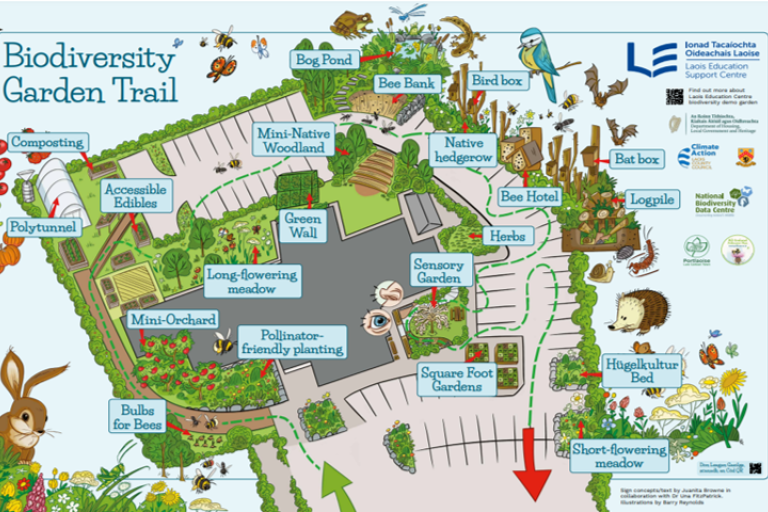It is a "living classroom" to teach educators and students about Irish native species and habitats for sustainable practices, biodiversity and pollination.
- Living Classroom
- Pollinator Lesson Plans
- "Town in a Garden" project
- How can our school get involved?
- Benefits of a demonstration garden
Biodiversity demonstration garden
Laois County Council was proud to unveil the biodiversity demonstration garden in the Laois Education Centre in June 2024. The garden will be used to inform educators on the practicalities of setting up a habitat top provide horticultural and environmental education.
Pollinator Lesson Plans
We are thrilled to introduce a collection of 10 engaging Pollinator Lesson Plans, thoughtfully designed to empower educators in teaching students about the essential role pollinators play in our ecosystems. Each lesson plan offers a blend of informative content and hands-on activities that not only captivate students but also reinforce key concepts through interactive learning. These plans are crafted to inspire a deeper appreciation for pollinators, fostering curiosity, stewardship, and an understanding of how these remarkable creatures contribute to the health of our environment.
Living classroom
Designed as a living classroom, the garden features a variety of biodiversity and pollinator-friendly habitats and projects with small footprints that can be incorporated into school grounds. It aims to promote awareness and understanding of biodiversity among teachers and the broader community, fostering environmental stewardship.
The garden includes:
- Mini-orchard
- Pollinator-friendly planting
- Square foot gardens
- Sensory gardens
- Native hedgerow / Mini-native woodland
- Herbs ground cover
- Bee hotel / Bee bank
- Bog pond
- Hügelkultur bed
- Short-flowering meadow
- Polytunnel
These are all designed to create a thriving ecosystem. By showcasing these elements, the garden provides practical examples of how schools can enhance biodiversity on their own grounds, regardless of size constraints.
"Town in a Garden" project
This project aligns with the Portlaoise Low Carbon Town (PLCT) initiative and the "Town in a Garden" concept, aiming to integrate green spaces into urban settings and promote sustainable living. These initiatives strive to create a harmonious balance between urban development and nature, encouraging communities to engage in sustainable practices.
The Biodiversity demonstration garden was funded by the Local Biodiversity Action Fund, with assistance in securing support and guiding the project.
The landscape plan for the garden was inspired by and incorporates principles from the "Gardening for Biodiversity" booklet. Educational signage throughout the garden provides information on the various species and habitats, enhancing the learning experience. These resources are available on Laois Education Support Centre offering further reading and guidance for schools and community members interested in biodiversity projects.
How can our school get involved?
This initiative is expected to inspire similar projects across the 200 schools within the catchment of the Laois Education Support Centre. By providing a practical example of how small-scale biodiversity projects can be implemented, the garden contributes to a broader movement towards learning and understanding of biodiversity.

Laois Education Support Centre invites schools and the community to visit the Biodiversity demonstration garden and engage with its educational programs. This hands-on learning environment aims to foster a deeper appreciation for Ireland’s rich natural heritage and encourage active participation in conservation efforts. Through awareness, education, and collaborative efforts, the garden serves as a catalyst for positive environmental change, setting a standard for other educational institutions and communities.
Benefits of a demonstration garden
The garden brings an array of benefits:
- Science Curriculum Integration
- Learning About Diversity
- Teamwork and Collaboration
- Promoting Sustainability
- Tackling Eco- or Climate Anxiety
- Hands-On Learning
- Understanding Ecosystems
- Understanding Pollination
- Observing Nature's Cycles
- Cultivating Stewardship Values
Science curriculum integration
A biodiversity garden aligns with science curriculum goals, but also offers opportunities to teach other subjects, including Maths, History, languages, and Geography.
Learning about diversity
Students can explore the concept of biodiversity by observing the variety of plants, insects, birds, and other wildlife present in the garden. This fosters an appreciation for the richness of life on Earth.
Teamwork and collaboration
Planning, planting, and maintaining a biodiversity garden can be a collaborative effort that fosters teamwork among students. It promotes a sense of responsibility and shared achievement.
Promoting sustainability
Your garden can serve as a model for sustainable practices. Students can learn about composting, water Conservation, and other practices that contribute to a sustainable future.
Tackling eco- or climate anxiety
Many young people express anxiety around the state of the planet and the future. Taking small positive biodiversity actions in their garden can help alleviate eco-anxiety.
Hands-on learning
A biodiversity garden provides students with a hands-on, experiential learning environment. It allows them to observe, interact with, and learn about plant and animal species firsthand.
Understanding ecosystems
Students can learn about ecosystems, food webs, and the interconnected relationships between different organisms. It promotes ecological literacy and a better understanding of our world.
Understanding pollination
The garden provides an opportunity to teach students about the importance of pollinators in food production. Observing pollinators in action helps students understand the critical role they play.
Observing nature's cycles
Students can observe the life cycles of plants and animals through the seasons. This experience deepens their connection to the natural world.
Cultivating stewardship values
A biodiversity garden instils a sense of environmental stewardship in students, encouraging them to appreciate and care for the natural world. It nurtures a sense of responsibility for the planet.
